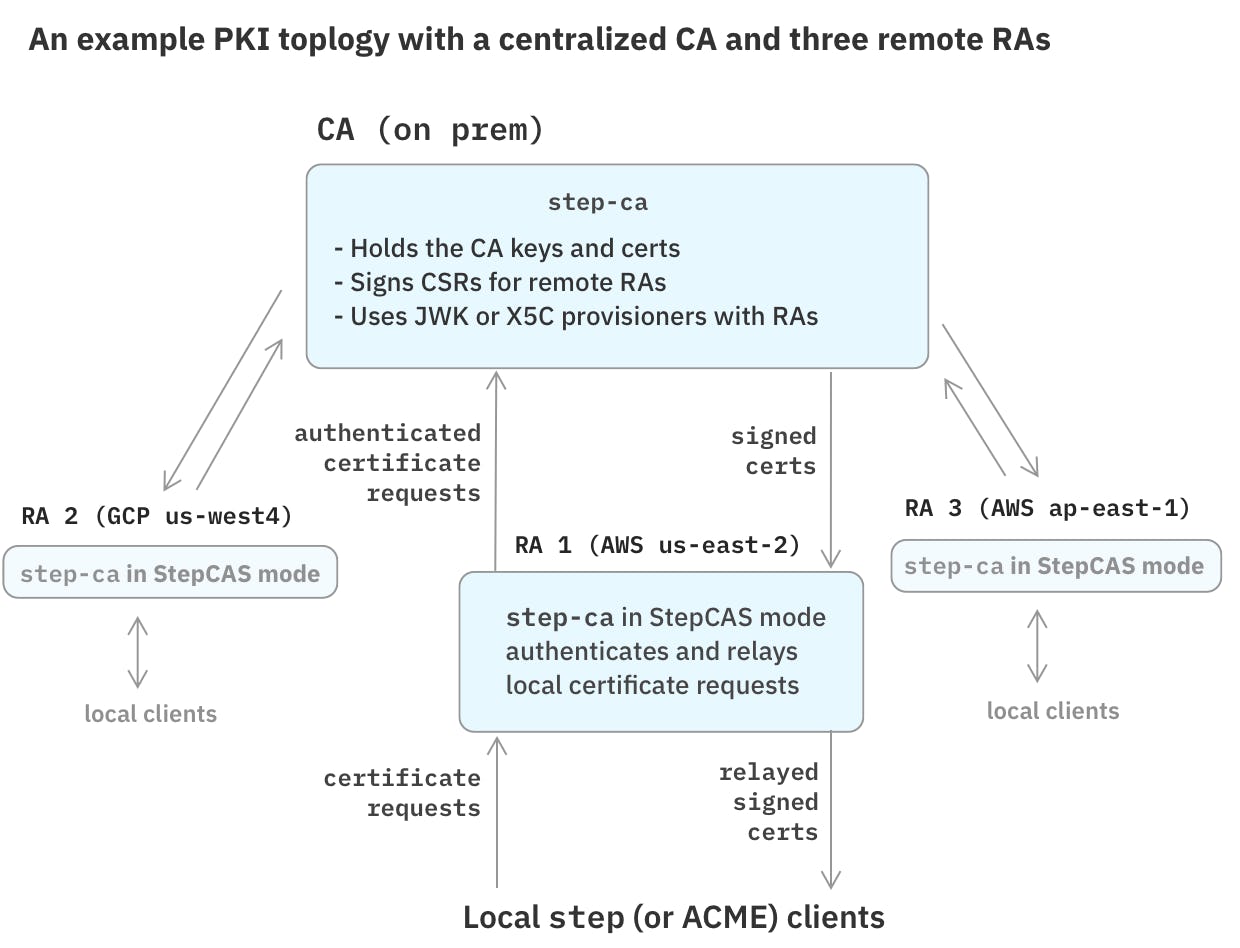Certificate Authority Core Concepts
This document defines and describes certificate authority core concepts that are integral to the design
and practical usage of step-ca.
Readers who are not yet familiar with public key infrastructure (PKI) and certificate management may want to check out...
- Everything you should know about certificates and PKI but are too afraid to ask
- The case for using TLS everywhere
Overview
- Online X.509 Certificate Authority
- Provisioners
- Certificate Issuance Policies
- Certificate Templates
- Active vs. Passive Revocation
- Other Operational Modes
step-ca is an online certificate authority, meaning it runs as a server
on the network and accepts certificate requests.
Provisioners
Provisioners are methods of proving an entity's identity to the CA prior to getting a new certificate. The CA needs proof that an entity that is requesting a new certificate is who they say they are. Once a provisioner authenticates an entity's identity, it then issues the entity a bearer token to submit to the CA, along with a certificate signing request (CSR), to obtain the new certificate.
The details of how a provisioner interacts with an entity (machines or people) and the CA vary by provisioner type. Smallstep supports a number of provisioner types including:
- ACME protocol
- OAuth/OIDC Single Sign-on
- AWS Instance Identity Documents
- Google Cloud Instance Identity Tokens
- Azure Instance Metadata Service
- Kubernetes Service Account Tokens
- SCEP protocol
- JWT for building custom integrations
Active vs. passive revocation
There are two certificate revocation methods: active vs. passive.
Private PKIs like step-ca uses passive revocation by default.
Passive revocation doesn't use Certificate Revocation List (CRL) and Online Certificate Signing Protocol (OCSP) like the Web PKI you may be familiar with.
To passively revoke a certificate means to block its renewal at the CA. This eliminates the additional network request that occurs when using a web PKI because the certificate just expires by itself. Unlike active revocation, certificates cannot be immediately revoked. Therefore, certificates should have a shorter lifetime to reduce the value of a key that has been exfiltrated.

Policies
With certificate issuance policies administrators can configure what Subjects, SANs and Principals the CA is allowed to sign.
An example of a policy is to only allow (strict) subdomains of internal.example.com, which would be encoded as *.internal.example.com.
Visit the step-ca policy page to learn how certificate issuance policies work and how they can be configured.
Templates
People use private CAs for all sorts of things, in many different contexts:
web apps, mobile apps, code signing, cloud VM instances, SSH, IoT devices, etc.
So step-ca must be flexible enough to handle a wide variety of flows.
X.509 and SSH certificate templates open up these possibilities. With certificate templates, you can do things like:
- Add custom SANs or extensions to X.509 certificates
- Make longer certificate chains, with multiple intermediate CAs
- Use SSH
force-commandorsource-addressextensions - Add conditionals around a certificate's parameters, and fail if they are not met
- Enrich a certificate with data from a webhook
Visit the step-ca templates page to learn how to use templates.
Other operational modes
Aside from being an online Certificate Authority, step-ca has a couple of non-standard modes of operation:
Registration Authority (RA) mode, and offline mode.
step-ca can operate in Registration Authority (RA) mode.
An RA is a server that acts as an authentication layer for an upstream signing CA.
RA mode lets you separate certificate request authentication (the RA) from certificate signing operations (the CA). This operational mode centralizes key management: a single CA can serve several RAs.
When in RA mode, step-ca can peer with three kinds of upstream CA:
- Another
step-caserver ("StepCAS" mode) - A Google CloudCAS CA
- A Hashicorp Vault CA

To create an RA-based PKI topology, see our Registration Authority (RA) Mode documentation.
Offline Mode
Sometimes it's useful to access a local CA offline, without running the step-ca server.
For this purpose, the step CLI can be used in offline mode (with the --offline flag).
Offline mode uses the configuration, database, certificates, and keys of an existing step-ca installation.
This table shows some of the feature differences between an online step-ca server, step CLI in offline mode, and the step certificate subcommand.

Example: Offline Mode
Let's create a certificate without step-ca:
$ step ca init --name "Local CA" --provisioner admin --dns localhost --address ":443"
$ step ca certificate --offline foo.smallstep.com foo.crt foo.key
Next Steps
- Read the Getting Started guide to set up a CA and get your first certificate.
Last updated on September 17, 2025
Introducing
Device Identity
Ensure that only company-owned devices can access your enterprise's most sensitive resources.